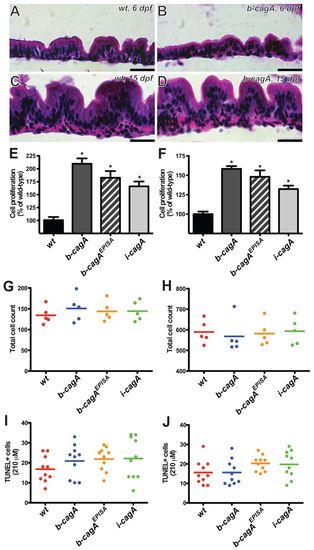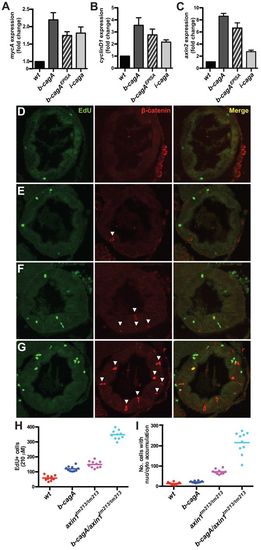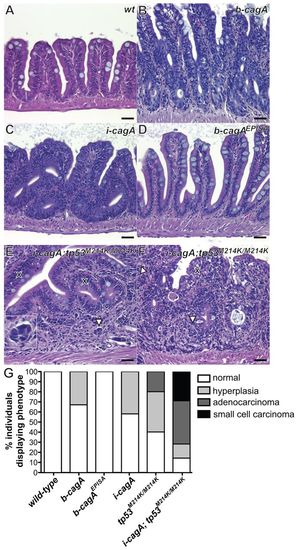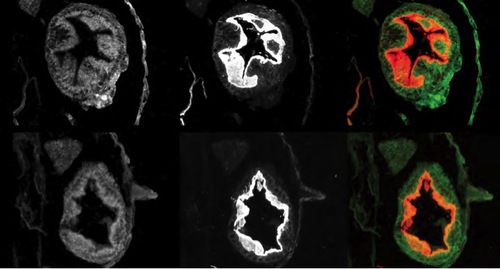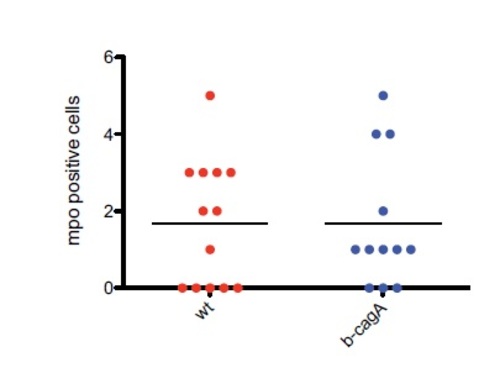- Title
-
H. pylori Virulence Factor CagA Increases Intestinal Cell Proliferation by Wnt Pathway Activation in a Transgenic Zebrafish Model
- Authors
- Neal, J.T., Peterson, T.S., Kent, M.L., and Guillemin, K.
- Source
- Full text @ Dis. Model. Mech.
|
Development of CagA+ transgenic zebrafish. (A) Ubiquitous CagA-EGFP fusion protein expression driven by the b-actin promoter. (B) Ubiquitous CagAEPISA-EGFP fusion protein expression driven by the b-actin promoter. (C) Intestinal CagA-EGFP fusion protein expression driven by the i-fabp promoter. (D) RT-PCR of dissected larval intestine showing expression of cagA and the housekeeping control gene RPL13 at 6 dpf. (E) Quantitative RT-PCR of dissected adult intestines showing relative expression levels of cagA transcript in transgenic lines at 1 year of age. Expression levels were normalized to SDHA and β-actin; bars indicate mean ± s.d. of biological triplicates. Scale bars: 500 μm. EXPRESSION / LABELING:
|
|
CagA expression causes overproliferation of the intestinal epithelium. (A,B) H&E stained sagittal sections of wild-type (A) and b-cagA transgenic (B) zebrafish intestine at 6 dpf. (C,D) H&E stained sagittal sections of wild-type (C) and b-cagA transgenic (D) zebrafish intestine at 15 dpf. (E,F) Intestinal epithelial cell proliferation at 6 dpf (E) and 15 dpf (F). Bars represent proliferation (mean ± s.e.m.) as a percentage of wild-type; n=10, *P<0.05 using one-way ANOVA with Tukey?s test. (G,H) Total intestinal epithelial cell counts of single H&E stained midline sagittal sections at 6 dpf (G) and 15 dpf (H). (I,J) TUNEL-positive cells in the intestinal epithelium at 6 dpf (I) and 15 dpf (J). Scale bars: 10 μm. PHENOTYPE:
|
|
CagA activates canonical Wnt signaling in the intestinal epithelium. (A?C) Quantitative RT-PCR data showing relative expression levels of the Wnt target genes mycA (A), cyclinD1 (B) and axin2 (C). Expression levels were assayed in dissected adult intestines and normalized to SDHA and β-actin; bars indicate mean ± s.d. of biological triplicates. (D?G) Immunofluorescence micrographs showing proliferating cells (EdU, green, 10-hour label) and cells with nuclear and cytoplasmic accumulation of β-catenin (red staining and white arrowheads) in intestinal cross-sections of wild-type (D), b-cagA (E), axin1tm213 (F) and b-cagA; axin1tm213 (G) animals at 6 dpf. (H) Quantification of proliferating (EdU+) cells. (I) Quantification of cells with nuclear and cytoplasmic accumulation of β-catenin. |
|
CagA-dependent overproliferation of the intestinal epithelium requires tcf4. Intestinal epithelial cell proliferation at 15 dpf. Bars represent proliferation (mean ± s.e.m.) as a percentage of wild-type; n=10, *P<0.05 using one-way ANOVA with Tukey?s test. PHENOTYPE:
|
|
CagA expression causes phosphorylation-dependent intestinal epithelial hyperplasia and induces adenocarcinoma formation in combination with p53 loss. (A?F) H&E stained sagittal sections of adult zebrafish intestine (A) Wild-type intestine at 18 months post-fertilization (mpf) showing normal intestinal architecture, with a single layer of epithelial cells lining the mucosal folds. (B,D) b-cagA (B) and i-cagA (D) intestines at 12 mpf, displaying mucosal fold epithelial hyperplasia, dysplasia within mucosal sulci and mucosal fold fusion. (C) b-cagAEPISA intestine at 12 mpf showing normal intestinal architecture, identical to wild-type. (E) i-cagA; tp53M214K/M214K small cell carcinoma with small nests of neoplastic cells in the lamina propria (arrowheads). Inset depicts higher magnification of tumor cells; the cross marks the epithelium. (F) i-cagA; tp53M214K/M214K adenocarcinoma, poorly differentiated, invade into the lamina propria with complete disorganization of the epithelium, as shown by goblet cells randomly scattered throughout (arrowheads). (G) Summary of intestinal histological abnormalities observed in adult CagA-expressing animals as a result of a blinded histological analysis of H&E stained sections (wild-type, n=22; b-cagA, n=24; b-cagAEPISA, n=18; i-cagA, n=19; tp53M214K/M214K, n=5; i-cagA/tp53M214K/M214K, n=7). Scale bars: 25 μm. |
|
CagA expression does not disrupt early intestinal morphology or cell polarity. Fluorescence micrograph of intestinal cross-sections of wild-type (A) and b-cagA (B) animals at 6 dpf showing green autofluorescence or staining with a pan-cadherin antibody. |
|
CagA expression does not result in increased inflammation. Myeloperoxidase (mpo)-positive neutrophils present in the intestine at 8 dpf. PHENOTYPE:
|


